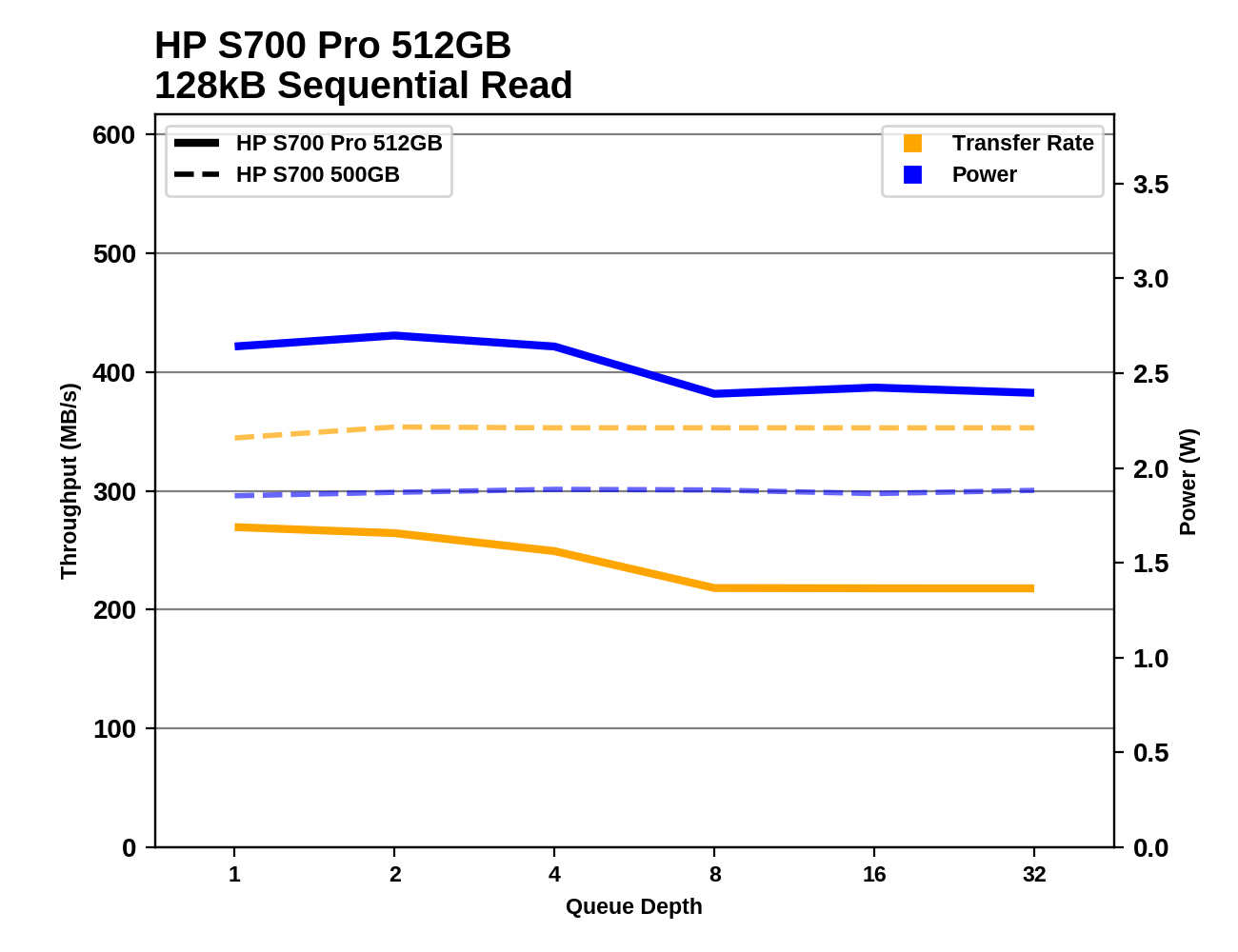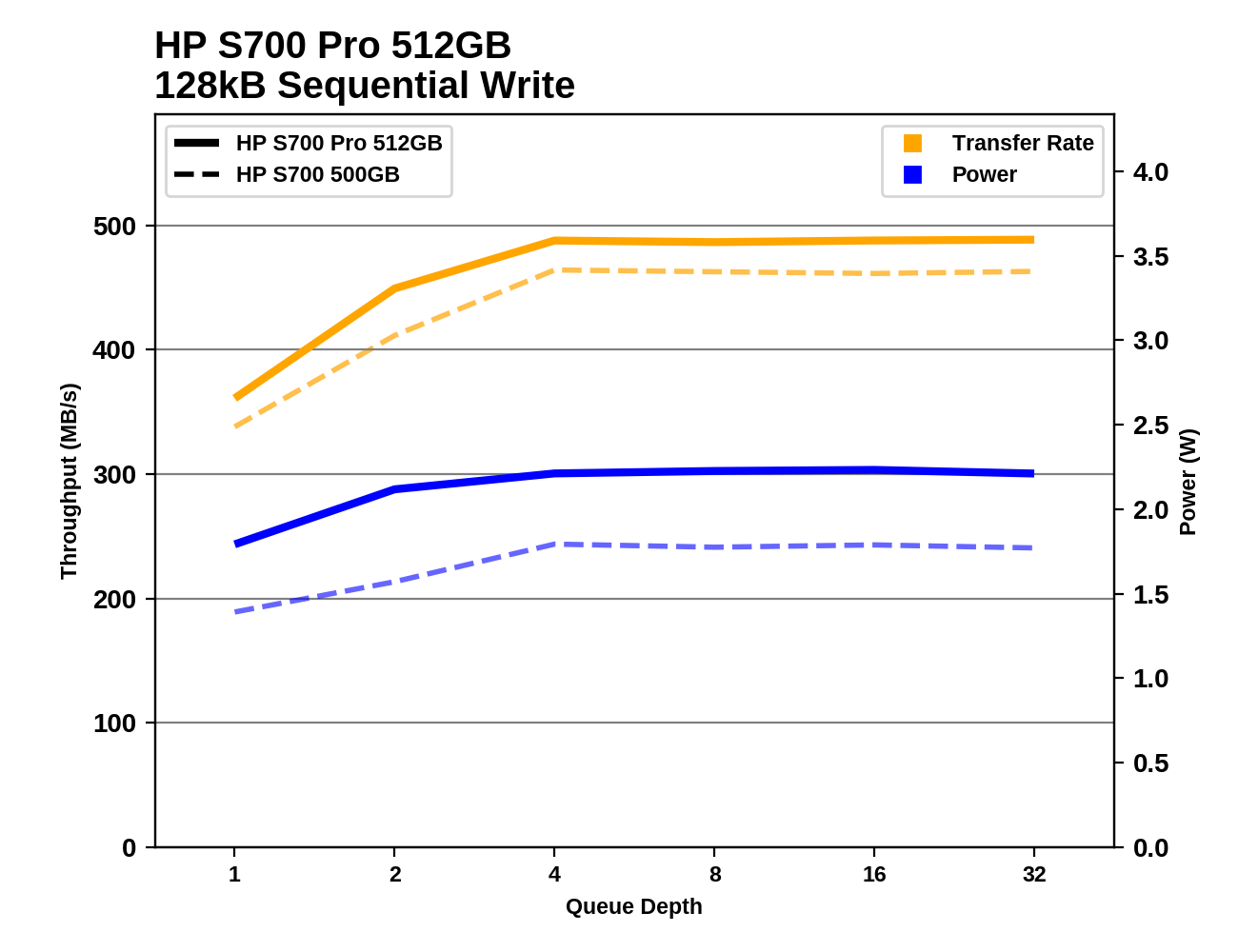The HP S700 And S700 Pro SSD Review
by Billy Tallis on September 7, 2017 9:00 AM ESTSequential Read Performance
Our first test of sequential read performance uses short bursts of 128MB, issued as 128kB operations with no queuing. The test averages performance across eight bursts for a total of 1GB of data transferred from a drive containing 16GB of data. Between each burst the drive is given enough idle time to keep the overall duty cycle at 20%.

The S700 and the larger two S700 Pros have great burst sequential read speeds, while the smallest S700 Pro has a bit of trouble (but still manages to outperform the smallest ADATA SU800 by 27%).
Our test of sustained sequential reads uses queue depths from 1 to 32, with the performance and power scores computed as the average of QD1, QD2 and QD4. Each queue depth is tested for up to one minute or 32GB transferred, from a drive containing 64GB of data.

On the longer sequential read test, the S700 doesn't drop to the bottom of the chart and instead offers above-average performance. The S700 actually has the fastest low queue depth sequential read speeds of any SATA SSD with Micron's 32L 3D NAND, including the MLC-based Crucial BX300. The S700 Pro is far slower and only its 128GB model beats the comparable ADATA SU800. We've asked HP if they can shed some light on how the S700 manages to deliver such an outstanding sequential read speed, because this is a very surprising result.

With good performance by TLC standards combined with the low power draw of a DRAMless Silicon Motion controller, the HP S700's power efficiency during sequential reads is great. The S700 Pro is near the bottom of the chart, but is a clear improvement over the ADATA SU800.
 |
|||||||||
Only a few drives have trouble delivering full performance for sequential accesses at QD1, and the HPs aren't on that list. The S700's performance is both higher and more stable across the test than the S700 Pro.
Sequential Write Performance
Our test of sequential write burst performance is structured identically to the sequential read burst performance test save for the direction of the data transfer. Each burst writes 128MB as 128kB operations issued at QD1, for a total of 1GB of data written to a drive containing 16GB of data.

The HP S700 is just a bit slower than average for burst sequential write speed, and the S700 Pro is right around the average. The Crucial MX300 and the smallest ADATA SU800 are the only real outliers on this test.
Our test of sustained sequential writes is structured identically to our sustained sequential read test, save for the direction of the data transfers. Queue depths range from 1 to 32 and each queue depth is tested for up to one minute or 32GB, followed by up to one minute of idle time for the drive to cool off and perform garbage collection. The test is confined to a 64GB span of the drive.

The longer sequential write test shows that the 120/128GB class drives are at a significant disadvantage, but the S700 Pro performs well among that cohort. The larger S700 and S700 Pro drives all offer decent sustained sequential write speeds and rank quite a bit higher than for the shorter sequential write test.

The larger two S700s join the OCZ VX500 at the top of the efficiency chart for sequential writes, and the larger S700 Pros aren't far behind. The smallest S700 Pro is far less efficient than its larger siblings, but offers 60% higher performance per watt than the ADATA SU800 and is in the top of its class (again, not counting the discontinued Samsung drives). The 120GB S700 has the lowest efficiency.
 |
|||||||||
The 500/512GB HP drives and the 250GB HP S700 don't saturate until QD4, while the 256GB S700 Pro manages to saturate at QD2. The 128GB S700 Pro runs out of spare area while the test is at QD2, so it never comes close to sustaining a speed that saturates the SATA link. The 120GB S700's performance is relatively consistent and increases somewhat with queue depth, but is overall still quite slow.










54 Comments
View All Comments
sonny73n - Saturday, September 9, 2017 - link
I understand that but where it'll lead us to? Most of things cost much more in the US compared to the same in China - from gasoline to food. A Chinese can cover his living expenses with just $1000/month while it takes at least twice that much for an American. Keep on rising the minimum wage will not solve the problem because we will be left with nothing to produce. Something's really messed up here.demMind - Monday, September 11, 2017 - link
sonny.. US Companies can afford to pay wages in the US. They just don't want to because executives love their year-over-year bonuses and dividends to grow. So no, prices haven't gone up because of cost of labor, they've gone up because each of us wants as much as we can get for as little extra effort as possible.Fujikoma - Thursday, September 14, 2017 - link
The price wouldn't be that much more. That extra labor savings is balanced by less efficient use of labor, material waste, shipping costs, increased counterfeit products, higher CEO pay and stock payouts if they exist (Apple is a good one for this). When companies moved to China, they did not lower their prices from cheaper labor. They lined their pockets with the extra cash. I worked for over a decade with a major electronics manufacturer invested heavily in China. Nothing but a headache for such a slim margin. That was with a 50X price margin on one of their highest volume products compared to a 12X price margin with the Mexican produced product (selling price relative to claimed materials + labor + storage + packaging + advertising + everything else involved). The higher margin is offset by shipping, defective/poorly made product, counterfeit product and material waste from poor manufacturing setup.As to the cheaper labor, that's because the U.S. allows product made from next to slave labor AND product made in environmentally damaging conditions to be imported into this country. Why do you think China has a pollution problem (aside from coal)... less regulation compared to Europe, Canada, Japan and the U.S.
Samus - Tuesday, December 26, 2017 - link
Sonny, you realize Lenovo lost the crown 2 years ago? They held the #1 spot for 14 quarters. HP has held the #1 spot for 39 quarters since 2006 when they took it from Dell.Nobody is hurt...except the Fortune 500 companies that blindly bought into Lenovo based on price, only to have their IT dept advocate for change almost immediately. Which aligns perfectly with the 3 year corporate product cycle and the amount of time Lenovo held the #1 sales edge in North America.
I'm an IT director, I know first hand the outcry my community had over Lenovo, and not just in relation to superfish.
petar_b - Tuesday, September 12, 2017 - link
I don't stand any of these big players HP, Lenovo.... It's all rip off, Lenovo's licensing is too complicated (can't activate features you paid for on hardware that they consider obsolete) and then on HP side plenty of similar crap. You almost feel bad for asking for something you own/deserve/paid.... I love SunMicro, chenbro, clean LSI or Adaptec works with everything. What HP SSD, that one will be backed by warranty only if attached to their mobo, or whatever other stupidity...Flunk - Thursday, September 7, 2017 - link
Marketing terms are always meaningless without context. You always need to read the specs behind the glossy advertising to know what you're buying. I don't see that changing any time soon.MajGenRelativity - Thursday, September 7, 2017 - link
AgreedyankeeDDL - Thursday, September 7, 2017 - link
I'm shocked by the price. Dramless, with those specs, should be $70, top, for the 240GB.Why in the world would I spend no less than $116, when the EVO sells for $90?!?!?!
Glock24 - Thursday, September 7, 2017 - link
Just what I was thinking. Pricing on these are ridiculous. They have a bit more storage size, but so does the Crucial MX300 and it's also way cheaper and faster!Samus - Thursday, September 7, 2017 - link
The MX300 is pretty much the only economy drive to consider outside of an 850 EVO IMHO. Even if these sell for half the retail price, they aren't worth it. You can just pickup an old M500 on eBay (or even an OEM Intel 520/530) for half these prices and have similar performance.